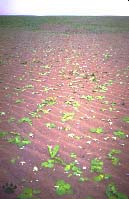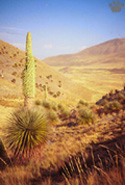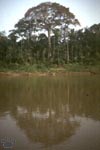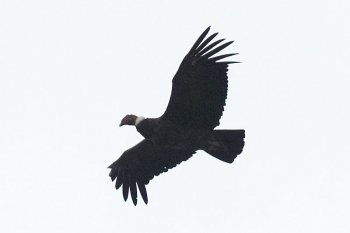|
From
a rearranged translation of Vladimir
Dinets original pages to norwegian,
with supplements.

Klikk på flagg for norsk versjon
Pages for Latin America
The Andes.
Being the World's longest mountain range, the
Andes are also the most interesting one.
Their astonishing natural diversity reaches its maximum in
Peru, where the western slope is rising
above the planet's driest desert, while the eastern slope
is covered with rain- and cloud forests.
If I was an extraterrestrial tourist and had to choose a place
for a once-in-a-lifetime month-long
vacation on Earth, I'd probably go to Peru.
So said the Author of those pages about The Andes.
When I started to rewrite this for www.vulkaner.no, I had
to admit that I did know very
little about Peru. The capital was Lima, and it is situated
somewhere in the central part of SA,
not too far from Equator..
Peru

I was right about
Equator, it crosses the border on the top. But what
then?
|
The Peruvian population, estimated at 29.5 million, is multiethnic,
including Amerindians, Europeans,
Africans, and Asians. The main spoken language is Spanish, although
a significant number of Peruvians
speak Quechua or other native languages. This mixture of cultural
traditions has resulted in a wide
diversity of expressions in fields such as art, cuisine, literature,
and music.
Peru covers 1,285,216 km2 . It borders Ecuador and Colombia
to the north, Brazil to the east, Bolivia
to the southeast, Chile to the south, and the Pacific Ocean
to the west. The Andes Mountains run
parallel to the Pacific Ocean; they define the three regions
traditionally used to describe the country
geographically. The costa (coast), to the west, is a narrow
plain, largely arid except for valleys created
by seasonal rivers. The sierra (highlands) is the region of
the Andes; it includes the Altiplano plateau as
well as the highest peak of the country, the 6,768 m Huascarán.
The third region is the selva (jungle),
a wide expanse of flat terrain covered by the Amazon rainforest
that extends east. Almost 60% of the
country's area is located within this region.
 Alpamayo
mountain in Peru.
Alpamayo
mountain in Peru.
Photo:
Brad Mering, http://en.wikipedia.org/wiki/File:Alpamayo.jpg
|
Most Peruvian rivers originate in the peaks of the Andes
and drain into one of three basins. Those that
drain toward the Pacific Ocean are steep and short, flowing
only intermittently. Tributaries of the
Amazon River are longer, have a much larger flow, and are
less steep once they exit the sierra.
Rivers that drain into Lake Titicaca are generally short and
have a large flow. Peru's longest rivers are
the Ucayali, the Marañón, the Putumayo, the
Yavarí, the Huallaga, the Urubamba, the Mantaro,
and the Amazon.
Peru, unlike other equatorial countries, does not have an
exclusively tropical climate; the influence of
the Andes and the Humboldt Current cause great climatic diversity
within the country. The costa has
moderate temperatures, low precipitations, and high humidity,
except for its warmer, wetter northern
reaches. In the sierra, rain is frequent during summer, and
temperature and humidity diminish with
altitude up to the frozen peaks of the Andes. The selva is
characterized by heavy rainfall and high
temperatures, except for its southernmost part, which has
cold winters and seasonal rainfall.
Because of its varied geography and climate, Peru has a high
biodiversity with 21,462 species of plants
and animals reported as of 2003; 5,855 of them endemic.
|
Queen
of the Andes, Puya
raimondii
|
|
|
|
|
Loma
de Lachay,
Coast of Peru
|
Giant Puia, Puya raimondii
Huascaran, Peru
|
Puya raimondii, also known as
the Queen of The Andes, is rivalled only by members of the
Ceroxylon palm genus as the most spectacular high-Andean
plant. It occurs in often very isolated
and usually small populations or rodales from Peru to Bolivia.
Communities frequently number
a few hundred individuals or less, but can range up to perhaps
30,000 plants in Paso Winchus as
well as in Cashapampa, Pachacoto and sector Carpa, Huascarán
National Park, Huaraz,
which is probably Peru’s best known location. Populations
reach 10,000 in Rodeo, Arani province,
Bolivia’s largest population which may represent one
third that country’s plants. In Titankayoc in
southern Peru’s Ayacucho, however, there is an extraordinary
site of several thousand hectares
which contains, depending on source, an estimated 250,000
to at least 450,000 plants.
 Puya
raimondii
Puya
raimondii
Departamento de Ayacucho (Perú)
Photo:
Pepe Roque |
The plant is monocarpic and in habitat seeds
only once in about 80 years or more before dying.
Although a mature Puya will produce 8–12 million seeds
and viability is usually good, inclement
montane conditions at the time of dispersal, which may inter
alia affect pollinating insects, can result
in few if any germinations. Moreover, seeds in less than ideal
conditions can begin to lose
germinating ability after a few months and are also susceptible
to damping-off. Because of these
factors, a century-old plant may not reproduce at all and
will, botanically, have lived in vain.
This risk is exacerbated by global warming whose effects on
Peru’s glaciers are well established.
Climate change may already be impairing Puya raimondii’s
ability to flower
 The
Puya raimondii grows in Vacas. It has the
The
Puya raimondii grows in Vacas. It has the
longest inflorescence in the world (up to 8 m tall,
depending on the environmental conditions).
The image is showing part of the inflorescence
with blossom.
Photo:
Foto: http://en.wikipedia.org/wiki/Vacas_Municipality |
This plant usually occurs at around 4,000 m
in the Andes of Peru and Bolivia, but it ranges from 3,000
m up to 4,800 m (both extremes occur in Bolivia).
Typical habitat for this species occurs at about 4,000 m but
can extend from 3,000–4,800 m. At these levels, air temperatures
range from very cold (as low as -20ºC or less) to an
estimated maxima of 8–24ºC.
Source: Lambe, A.
2009. Puya raimondii. In: IUCN 2011. IUCN Red List of Threatened
Species. Version 2011.2. <www.iucnredlist.org>. Downloaded
on 28 February 2012
|
|
|
|
The
'dry' season brings fog
over Rio Manu
|
Flowering
Seiba pintandra,
Manu NP
|
And between those two contrasts we find
the Mountains
|

Sunset in Cordillera Blanca, Peru. |

Orchids, Machu Picchu.
|

One of Cordillera Blanca peaks |
The Andes are very beautiful.
The inner part of Peruvian Andes is the high Altiplano plateau.
It looks very much like Tibet.
Just like in Tibet, mountain ridges around the plateau are sliced
with very deep, narrow gorges.

Salt Lake
at Peru-Bolivian border. |
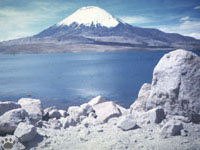
Lauca National Park at
Peru-Chilean border. |

Ucayali River canyon
near Machu Picchu. The
white spot at the bottom
is a railroad station.
|

Colca Canyon,
the deepest in the Americas.
|

These rock faces in Colca Canyon shelter breeding colony
of Andean condors, Vultur gryphus. |
Andean
Condor, Vultur Gryphus
 Andean
Ckondor, Vultur gryphus
IMSI's
MasterClips(MasterPhotos(C) Collection,
Andean
Ckondor, Vultur gryphus
IMSI's
MasterClips(MasterPhotos(C) Collection,
1895 Francisco Blvd.East, San Rafael, CA 94901-5506, USA
|
The Andean Condor is said to be the largest of all living
birds of prey. It breeds from Venezuela in the North and all
the
way down to Tierra del Fuego. Of course it is not numerous all
over. In the Western Argentine and in Columbia they
are relatively few.
When they form great flocks of 60 birds, they make a marvelous
look. As the eagles of the Andes, they find warm
up-winds and circle by means of them higher and higher.
The Andean Condor, Vultur gryphus, is a species of South American
bird in the New World vulture family Cathartidae
and is the only member of the genus Vultur. Found
in the Andes mountains and adjacent Pacific coasts of western
South America, it has the largest wingspan at 3.2 m of any land
bird.
It is a large black vulture with a ruff of white feathers surrounding
the base of the neck and, especially in the male, large
white patches on the wings. The head and neck are nearly featherless,
and are a dull red color, which may flush and
therefore change color in response to the bird's emotional state.
In the male, there is a wattle on the neck and a large,
dark red comb or caruncle on the crown of the head. Unlike most
birds of prey, the male is larger than the female.
The condor is primarily a scavenger, feeding on carrion. It
prefers large carcasses, such as those of deer or cattle.
It reaches sexual maturity at five or six years of age and nests
at elevations of up to 5,000 m , generally on inaccessible
rock ledges. One or two eggs are usually laid. It is one of
the world's longest-living birds, with a lifespan of up to
100 years old in captivity.
Source: http://en.wikipedia.org/wiki/Andean_Condor
|
 Andean
condor, Vultur gryphus - Overview
Andean
condor, Vultur gryphus - Overview
BBC Natural History Unit
http://www.arkive.org
|
The eco-tourism industry is booming. One hotspot
in South Eastern Peru attracts over 40,000 visitors a year
as it's one of the best places in world to practice birdspotting.
It seems though, that the sound of tourists
talking is getting in the way of them seeing the full spectrum
of species. Daniel Karp, Stanford University graduate and
long-time birdspotter talked to Earth Beat about the impact
that the noise from well-meaning birdwatchers is having on
the birds' habitat.
Ecotourists who "ooh" and "aah" over the
marvels of nature may be doing more harm than if they appreciated
the animals silently. Some species, it turns out, become significantly
more stressed by even quiet conversation.
http://www.rnw.nl/english/article/birdspotters-stress-out-peruvian-birds
|
  foto: http://www.hawk-conservancy.org/priors/george.htm
Lama,
Lama glama
foto: http://www.hawk-conservancy.org/priors/george.htm
Lama,
Lama glama
 Photo:©
William Albert Allard, National Geographic Magazine, May,
1996
Photo:©
William Albert Allard, National Geographic Magazine, May,
1996 |
Llamas and alpacas are the most important domestic animals of the
Altiplano.
Llamas were also the only freight transport of Inca Empire -
that's why ancient Inca roads have steps instead of switchbacks.

Llama, Cerros de Amotape |

Alpacas, Fitzcarraldo Pass |
The Llama, Lama glama is a South American camelid, widely
used as a meat and pack animal by Andean cultures
since pre-Hispanic times.
The height of a full-grown, full-size llama is 1.7 to 1.8 m
tall at the top of the head, and can weigh between 130 to 200
kilograms
At birth, a baby llama (called a cria) can weigh between 9 and
14 kilograms . Llamas can live for a period of about 20–30
years
depending on how well they are taken care of. Llamas are very
social animals and live with other llamas as a herd.
The wool produced by a llama is very soft and lanolin-free.
Llamas are intelligent and can learn simple tasks after a few
repetitions. When using a pack, llamas can carry about 25% to
30% of their body weight for several miles.
The name llama (in the past also spelled 'lama' or 'glama')
was adopted by European settlers from native Peruvians.

A
girl and her Llama
In Cuzco, Peru
Photo:
Thomas Quine
|
As of 2007, there were over 7 million llamas and alpacas in
South America and, due to importation from South America in
the late 20th century, there are now over 158,000 llamas and
100,000 alpacas in the US and Canada.
Llamas which are well-socialized and trained to halter and lead
after weaning are very friendly and pleasant to be around.
They are extremely curious and most will approach people easily.
However, llamas that are bottle-fed or over-socialized
and over-handled as youngsters will become extremely difficult
to handle when mature, when they will begin to treat humans
as they treat each other, which is characterized by bouts of
spitting, kicking and neck wrestling. Anyone having to bottle-feed
a cria should keep contact to a minimum and stop as soon as
possible.
When correctly reared, llamas spitting at a human is a rare
thing. Llamas are very social herd animals, however, and do
sometimes spit at each other as a way of disciplining lower-ranked
llamas in the herd. A llama's social rank in a herd is
never static. They can always move up or down in the social
ladder by picking small fights.
Source: http://en.wikipedia.org/wiki/Llama |
Andean
Cock-of-the-rock, Rupicola peruviana
 Andean
Cock-of-the-rock, Rupicola peruviana. A male at San
Diego Zoo, USA.
Andean
Cock-of-the-rock, Rupicola peruviana. A male at San
Diego Zoo, USA.
Photo: Jerry
Thompson
http://en.wikipedia.org/wiki/File:Rupicola_peruviana_(male)_-San_Diego_Zoo-8a.jpg
|
The Andean Cock-of-the-rock, Rupicola peruvianus,
is a medium-sized passerine bird of the Cotinga family
native to
Andean cloud forests in South America. It is widely regarded
as the national bird of Peru.
The species exhibits marked sexual dimorphism; the male has
a large disk-like crest and scarlet or brilliant orange plumage,
while the female is significantly darker and browner. Gatherings
of males compete for breeding females with each male
displaying its colourful plumage, bobbing and hopping, and making
a variety of calls. After mating, the female makes a nest
under a rocky overhang, incubates the eggs, and rears the young,
all by herself.
The Andean Cock-of-the-rock is a medium-sized, approximately
32 cm long and weighing 235 grams, passerine
which
exhibits marked sexual dimorphism. The male has a large disk-like
crest and scarlet or brilliant orange plumage. It has black
tail and wings, and pale grey scapulars. The female is significantly
darker and browner than the male and has a shorter crest.
The bill is yellowish in the male, and dark with a small yellow
tip in the female. Depending on gender and subspecies there
are
significant variations in the colour of the iris, ranging from
red over orange and yellow to bluish-white in the male, and
whitish
over reddish to brown in the female. In addition to the display
calls described in the breeding section below, foraging birds
give a loud querulous "uankk?" when disturbed or in
flight.

Two
male Andean Cocks-of-the-rock in Peru.
Photo:
Ricardo Sánchez
http://en.wikipedia.org/wiki/File:Rupicola_peruvianus_-Peru_-two-8.jpg
|
The Andean Cock-of-the-rock is distributed in cloud forests
of the Andes in a large range of about 260,000 km² across
Venezuela, Colombia, Ecuador, Perú, and Bolivia, mostly
in ravines and forested streams in montane areas at 500–2400
meters elevation. It typically stays in the lower and middle
forest levels, but will range higher in fruiting trees and
sometimes
will enter and cross clearings. It is generally shy and inconspicuous,
often seen only briefly after being flushed or swiftly
flying down a valley.
The diet consists mainly of fruit and insects, although small
vertebrates such as frogs or lizards have been recorded.
They are one of many species recorded following army ants.
Source: http://en.wikipedia.org/wiki/Andean_Cock-of-the-rock
|

Illimani,
Bolivia.
So far, we have been climbing the mountains. Now let us see what
happens if we go into the Jungle
The Peruvian Amazon is the area of the Amazon jungle included
in the territory of Peru, from the east of the Andes to borders
with Ecuador, Colombia, Brazil and Bolivia. This region comprises
60% of the country and is marked by a large degree of
biodiversity. Peru has the second largest portion of the Amazon
rain forest after the Brazilian Amazon.
Most Peruvian territory is covered by dense Amazon forests on
the east side of the Andes, yet only 5% of Peruvians live in this
area. The Amazon rain forest covers more than 60 percent of Peruvian
territory, more than in any other country save Brazil.
 Photo:
Ricardo Sánchez
Photo:
Ricardo Sánchez |
The lowland jungle (in Spanish Selva Baja) is also known as Omagua
region, Walla, Anti, Amazonian rainforest or Amazon basin.
This ecoregion is the largest of Peru, standing between 80 and
1000 meters above sea level. It has very warm weather with an
average temperature of 28°C, high relative humidity (over
75%) and yearly rainfall of approximately 2.500mm. Its soils are
very
heterogeneous but almost all have river origins, and due to high
temperatures and high rainfall they are poor soils with few nutrients.
Of the 1816 bird species, and of the 462 of the mammals in Peru,
805 different birds and 293 of the mammals are to be found
the Peruvian Amazon. 19 percent of all the birds in the world
live in Peru.
Source: http://en.wikipedia.org/wiki/Peruvian_Amazon
|
 Jungle
Photo:
Ricardo Sánchez
Jungle
Photo:
Ricardo Sánchez
|
First of all, just don't walk into the Jungle without
a guide!
You never know what you will find there - or whom will find you......
American
alligator, Alligator mississippiensis
 Alligator
(Caimán in Peru)
Alligator
(Caimán in Peru)
Photo:
Ricardo Sánchez |
An alligator is a crocodilian in the genus Alligator
of the family Alligatoridae. There are two living alligator
species: the American alligator, Alligator mississippiensis,
and the Chinese alligator, Alligator sinensis.
The name alligator is an anglicized form of el lagarto, the Spanish
term for "lizard", which early Spanish explorers and
settlers in Florida called the alligator.
A large adult American alligator's weight and length is360 kg
and 4.0 m long, but can grow to 4.4 m long and
weigh over 450 kg.The largest ever recorded was found in Louisiana
and measured 5.84 m.
The Chinese alligator is smaller, rarely exceeding 2.1
m in length. Alligators have an average of 75 teeth.
There is no measured average lifespan for an alligator. In 1937,
a one year-old specimen was brought to the Belgrade Zoo in Serbia
from Germany. It is now 76 years old. Another specimen, Cabulitis,
in Riga Zoo, Latvia died in 2007 being more than 75 years old.
 Alligator
eggs and young alligators
Alligator
eggs and young alligators
http://en.wikipedia.org/wiki/File:Alligator_eggs_and_young_alligators.jpg
|
When young, alligators eat fish, insects, snails, crustaceans,
and worms. As they mature, progressively larger prey is
taken, including larger fish such as gar, turtles, various mammals,
birds, deer and other reptiles. Their stomachs also
often contain gizzard stones. They will even consume carrion if
they are sufficiently hungry. Adult alligators can take
razorbacks and deer and are well known to kill and eat smaller
alligators. In some cases, larger alligators are known
to ambush dogs, Florida panther and black bears,
making it the apex predator throughout its distribution. As humans
encroach onto their habitat, attacks are few but not unknown.
Alligators, unlike the large crocodiles, do not immediately
regard a human upon encounter as prey, but may still attack in
self-defense if provoked. (Just so you know....)
 White
alligator.
Photo:
Ricardo Sánchez
White
alligator.
Photo:
Ricardo Sánchez |
There are two kinds of white alligators, albino and leucistic.
These alligators are extremely rare and practically impossible
to find in the wild. They could survive only in captivity. As
with all white animals, they are very vulnerable to the sun and
predators.[16] Like other albino vertebrates, albino alligators
have a non-functional allele for a gene controlling one step in
the melanin biosynthetic pathway.[16] It is the absence of the
melanin pigment that makes them albino. In leucistic alligators,
all skin pigments are absent—not just melanin. This makes
them white with blue eyes.
Source: http://en.wikipedia.org/wiki/Alligator |
 Photo:
Ricardo Sánchez
Photo:
Ricardo Sánchez |
The Scarlet Macaw, Ara macao, or
Guacamayo escarlata in spanish, is a large, colorful macaw. It
is native to humid
evergreen forests in the American tropics. Range extends from
extreme south-eastern Mexico to Amazonian Peru,
Bolivia and Brazil in lowlands up to up to 1,000 m. It has suffered
from local extinction through habitat destruction
and capture for the parrot trade, but locally it remains fairly
common. Formerly it ranged north to southern Tamaulipas.
It can still be found on the island of Coiba. It is the national
bird of Honduras.
 Photo:
Ricardo Sánchez
Photo:
Ricardo Sánchez |
Measured between 81 and 96 cm long and weighs 1060 to 1125 g .
Male and female adults are usually red,
with blue on the lower back. The tail is red with a blue tip.
In the wings are yellow feathers, which may have a green
tip. The top of the peak (upper jaw) is clear with a black mark
on each side, at the base. The bottom of the peak (lower jaw)
is black. Among the lower jaw and the eye is a white area of skin
without feathers. The eyes are yellow.
Hatchlings have a shorter tail and gray eyes, in addition, its
lower jaw is clearer.
In Costa Rica , the scarlet macaw was common both in the region
of the Pacific and in the Caribbean until the last
century, but now almost nonexistent on the Caribbean side and
the main populations persist in the National Parks
Corcovado and Carara , and in the Guanacaste Conservation Area
.
They feed on seeds, fruits, nuts, flowers and nectar. Can be seen
in tall trees and deciduous lowland forest or near
streams. Among them, take advantage of the fruits and seeds of
trees of the genus Eschweilera , Hura , Spondias
and Terminalia .
 Photo:
Ricardo Sánchez
Photo:
Ricardo Sánchez
|
|
With more than 800 different bird-species to be found here, lets
look at some more:
Snakebird,
Anhinga anhinga
 Anhinga
anhinga
Anhinga
anhinga
Photo:
Ricardo Sánchez
|
The Anhinga, Anhinga anhinga, sometimes called Snakebird, Darter,
American Darter, or Water Turkey, is a water
bird of the warmer parts of the Americas. The word "anhinga"
comes from the Brazilian Tupi language and means
devil bird or snake bird.
It is a cormorant-like
bird with an average body length of 85 cm, a wingspan of 117 cm,
and a mass of 1.35 kg.
It is a dark-plumaged piscivore with a very long neck, and often
swims with only the neck above water.
When swimming in this style the name Snakebird is apparent, since
only the colored neck appears above water
the bird looks like a snake ready to strike.
The Anhinga is placed in the darter family, Anhingidae,
and is closely related to Indian Darter, Anhinga melanogaster,
African Darter, Anhinga rufa, and Australian Darter, Anhinga
novaehollandiae.
 A
juvenile Anhinga in Uarini, Amazonas, Brazil. 2010.
A
juvenile Anhinga in Uarini, Amazonas, Brazil. 2010.
Photo: Cláudio
Dias Timm |
Unlike ducks, the Anhinga is not able to waterproof its
feathers using oil produced by the uropygial gland.
Consequently, feathers can become waterlogged, making the bird
barely buoyant. However, this allows it to dive
easily and search for underwater prey, such as fish and amphibians.
It can stay down for significant periods.
When necessary, the Anhinga will dry out its wings and
feathers, with the resemblance of the semicircular full-spread
shape of its group of tail feathers while drying them out, to
that of true meleagrine males lending the name "water turkey"
to it. It will perch for long periods with its wings spread to
allow the drying process, as do cormorants.
If it attempts to fly while its wings are wet, it has great difficulty
getting off the water and takes off by flapping
vigorously while 'running' on the water. Anhinga will often search
for food in small groups.
Source:
http://en.wikipedia.org/wiki/Anhinga |
 Photo:
Ricardo Sánchez
Photo:
Ricardo Sánchez |
There are about 19 different Turtles and Tortoises in Peru.
To say which is which, without having talked to them ourselves,
seems to be very difficult. So here lets just what is the difference
between a turtle and a tortoise.
Turtles are reptiles of the order Testudines (the
crown group of the superorder Chelonia), characterised
by a special bony
or cartilaginous shell developed from their ribs that acts as
a shield. "Turtle" may either refer to the Testudines
as a whole,
or to particular Testudines which make up a form taxon
that is not monophyletic. Turtles are marine reptiles.
Like other reptiles, turtles are ectotherms—their internal
temperature varies according to the ambient environment,
commonly called cold-blooded. However, leatherback sea turtles
have noticeably higher body temperature than surrounding
water because of their high metabolic rate.
 Photo:
Ricardo Sánchez
Photo:
Ricardo Sánchez |
Like other amniotes (reptiles, dinosaurs, birds, and mammals),
they breathe air and do not lay eggs underwater, although
many species live in or around water. The largest turtles are
aquatic.
Tortoises, Testudinidae are a family of land-dwelling
reptiles of the order of turtles, Testudines.
Like their marine cousins, the sea turtles, tortoises are shielded
from predators by a shell. The top part of the shell is the
carapace, the underside is the plastron, and the two are connected
by the bridge. The tortoise has both an endoskeleton
and an exoskeleton. Tortoises can vary in size from a few centimeters
to two meters. Tortoises are usually diurnal animals
with tendencies to be crepuscular depending on the ambient temperatures.
They are generally reclusive animals.
Source: http://en.wikipedia.org/wiki/
- Tortoise and -Turtle |
White-rumped Hawk, Buteo leucorrhous
 White-rumped
Hawk, Gavilán Negro in Peru, Buteo leucorrhous
White-rumped
Hawk, Gavilán Negro in Peru, Buteo leucorrhous
Photo:
Ricardo Sánchez |
The White-rumped Hawk, Buteo leucorrhous,
is a species of bird of prey in the Accipitridae
family.
It is found in Argentina, Bolivia, Brazil, Colombia, Ecuador,
Paraguay, Peru, and Venezuela. Its natural habitat is subtropical
or tropical moist montane forests. |
Purus
red howler, Alouatta puruensis
| |

Monos aulladores
Photo:
Ricardo Sánchez |
The Purus red howler, Alouatta puruensis, is a
species of howler monkey native to Brazil and Peru.
Howler monkeys,( genus Alouatta monotypic in subfamily
Alouattinae) are among the largest of the New
World monkeys. Fifteen species are currently recognised. These
monkeys are native to South and Central American forests. Threats
to howler monkeys include human predation, habitat destruction
and being captured
for captivity as pets or zoo animals.
Howler monkeys have a short snout, and wide-set, round nostrils.
They range in size from 56 to 92 cm, excluding
their tail which can be equally as long. Like many New World monkeys,
they have prehensile tails. Unlike other New
World monkeys, both male and female howler monkeys have trichromatic
color vision.
 Photo:
Ricardo Sánchez
Photo:
Ricardo Sánchez |
They have a lifespan of 15 to 20 years. Males are, on avePhoto:
Ricardo Sánchez rage, 1.5 to 2
kg heavier than females.
Howler monkeys generally move quadrupedally on the tops of branches,
usually grasping a branch with at least two
hands or one hand and the tail at all times. They have strong
prehensile tails which are able to support the monkey's
entire body weight. But fully adult howler monkeys don't often
rely on their tail for full body support whereas juveniles
do so more frequently.
Source: http://en.wikipedia.org/wiki/Howler_monkey |
  Capuchino
Photo:
Ricardo Sánchez
Capuchino
Photo:
Ricardo Sánchez |
The capuchins are the members of the genus Cebus
of primates world monkeys of Central and South , are named after
the monks Capuchins , whose hood has a similar color to
the hairs surrounding the face of these monkeys.
The Capuchins are small, typically about 45 cm long with a tail
prehensile arms wrap around to help in moving around the
trees. It is believed that the capuchin monkey is the most intelligent
New World monkeys, likes to explore and when
observed in captivity, often reduced to pieces the things that
is. In general the young monkey is lighter than the adult,
its tail is the same length as the body. Normally live in herds,
so when released captive capuchins is always done in groups.
Source: http://es.wikipedia.org/wiki/Mono_capuchino |
That is the end of our look at Peru. Now let's go further south...
Part 2. Chile
All
pictures, unless otherwise stated, Copyright © Vladimir
Dinets
The photos by Ricardo
Sánchez comes from this excellent gellery of Peruvian nature
and folklore at http://www.flickr.com/photos/foolonhill/sets/72157620983967166/
under the following limits: http://creativecommons.org/licenses/by/2.0/deed.en
|










